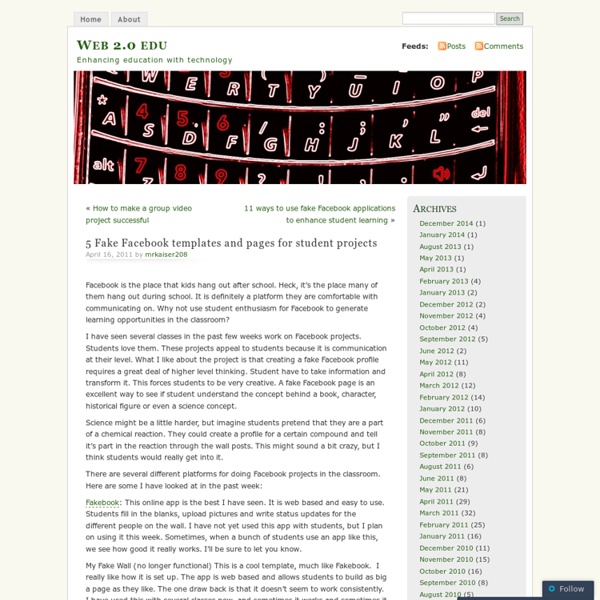5 Fake Facebook templates and pages for student projects

Nameless, Faceless Children (Blogs & Internet Safety)
I hereby propose that all children wear bags over their heads any time they leave the privacy of their own home (and even within it if said home has a webcam, camera, video camera, or cell phone) and cease to be called by names, but rather by a hexidecimal code that rotates regularly by security token so no single child can ever be readily identified. This act shall be called the Child Real-life Act of Protection, otherwise known as CRAP. That’s what we need to do right? Scenario 1: Johnny has a recreational soccer game on Saturday morning for the 7 & 8 year old league, which was published in the newspaper. Here’s my question: What exactly are we protecting them from? Personally, I believe that students are much more ‘at risk’ when the adults in their lives don’t think about what information they share locally. And guess what… I hope you’re sitting down, because this is BIG… elementary schools have children in attendance! Hello, world- meet my 3rd grade son, Caleb Cunningham! Like this:
30 of Your Best Tips for NQTs
We did a piece a week back on advice for NQTs to help them get their work-life balance in order. The feedback from that just reemphasised to me what a tricky transition those early years of teaching can be, so I decided to get the best possible advice for all those aspiring NQTs out there – from you! If you’ve got more advice I’d love to hear it, just comment below or tweet me with the hashtag #nqttips. And if you like it – don’t forget to share it! Give Yourself a Break and Don’t Beat Yourself Up [blackbirdpie url=" 2) Try not to wake up at the usual work time at weekends or holidays – @bio_joe 3) Teacher wellbeing comes first! 4) You MUST preserve some sort of inner life and ensure that you mind is constantly enriched. 5) Remember the first year is always the hardest! 6) Come & talk/cry to us at end of day! Be Inspired by the Best [blackbirdpie url=" 8) Observe lessons outside your subject area – @bio_joe Keep Organised Connect with your Students
How can a font alleviate reading problems
Dyslexics invert and transpose letters because they confuse letters that look alike. The switching of b and d, for example, is very common because the letters are simply reflections of each other. (In fact, dyslexia is much more common for English readers than readers of other languages, like Italian, in which words are spelled phonetically more than they are in English.) One of the biggest variables today in how we read are fonts—the visual style of letters. Fonts are designed in part with aesthetic goals, but there are features of fonts that can make reading easier or not. If some fonts help us read, could a font alleviate the impact of dyslexia? When another graduate student tested the font with a group of people with dyslexia, it proved to be effective in reducing errors and easing the physical difficulty dyslexics can experience while reading. Learn about how dyslexia affects the brain here. We’re excited about this remarkable way to affect reading. What’s good about it? How much?
Related:
Related:



